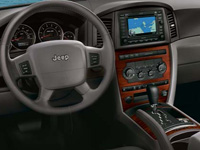 |
When you're pouring syrup all over those breakfast pancakes, consider what it has in common with Jeep's new Grand Cherokee CRD. (That's not as obscure as it might sound.) Pancake syrup can be made from corn, while corn or soybean oil is an ingredient in a fuel called "bio-diesel." A blend of five-percent bio-diesel called "B5" will work in the new diesel-version of Jeep's popular SUV.
New tough federal fuel emissions standards for 2007 are making major changes in diesel-driven vehicles. And Jeep Grand Cherokee CRD is the first domestic side sport utility to jump on the diesel bandwagon thanks to a new "scrubber" technology called "BLUETEC" from parent company DaimlerChrysler designed to eliminate diesel pollutants.
U.S. diesel lore has been one of smelly, smoky, sluggards that had to go into a lower gear to get up a hill. Today's diesels are a 180-degree shift. The Grand Cherokee CDR for 2007 doesn't have the ear bending heavy diesel rattle. Instead, expect a smoother idling, quieter, essentially odorless powerhouse that can run on a diesel/bio-fuel blend, and crank out the needed rpms for good handling and serious on or off-road duty.
The bio-diesel Jeep comes in two well-equipped Limited and two Overland (offroad) versions ranging from just under $40,000 to about $46,000 (in 4X4).
Diesels aren't new to Chrysler, which sells them in Europe. The Mercedes-built 3.0-liter CRD (for common rail diesel) in the Grand Cherokee is a V-6 producing 215-HP, and earning 20/25 best mileage, or about 450 miles on a single tank. It also emits about 20 percent less carbon dioxide into the atmosphere. Although a gallon of diesel can cost more than gasoline, diesel vehicles are legendary for living long lives.
Jeep is serious about presenting the environmental advantages of driving with bio-fuel. As the SUVs come off the assembly line, they are filled with B5. And as more bio-diesel plants come online, finding it in the future should get easier.
|